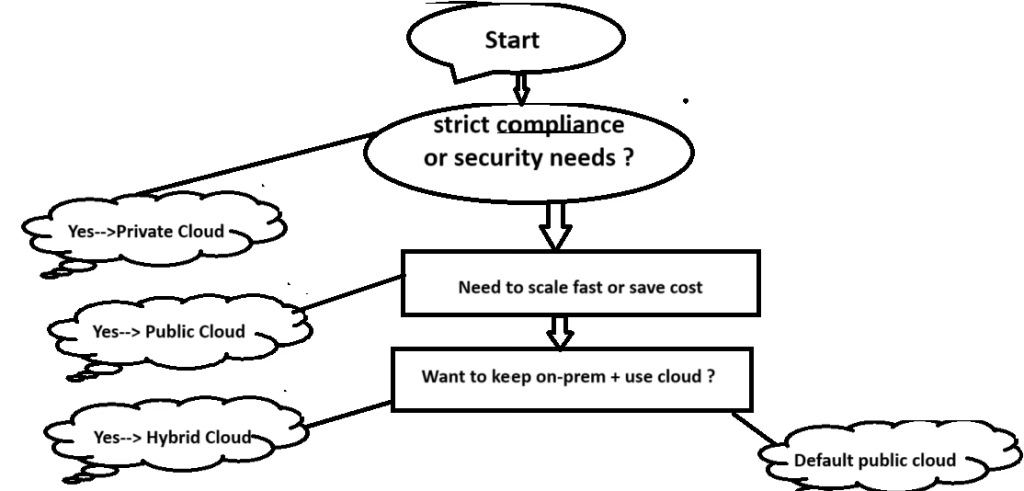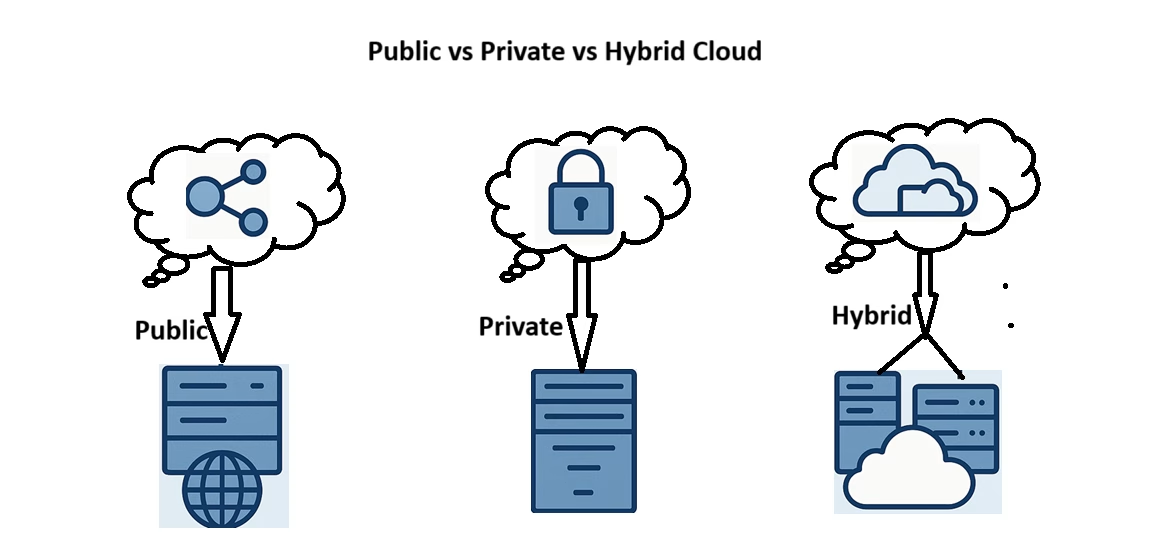When evaluating cloud strategies, many engineers and decision-makers ask the same question: Should we choose public, private, or hybrid cloud? While the answer depends on several factors, this decision shouldn’t be made hastily. Instead, it should be based on a clear understanding of your business objectives, regulatory requirements, and technical needs.
This article outlines the key differences between these three cloud models—public, private, and hybrid—to help organizations of all sizes make informed, strategic decisions. You’ll gain insight into when to use each model, along with the associated benefits, costs, and common use cases.
As digital transformation accelerates across industries, cloud computing has become an essential backbone for innovation and agility. The right cloud deployment model can have a profound impact on your organization’s cost structure, security posture, scalability, and operational efficiency.
In the sections that follow, we’ll break down the core characteristics of each model, compare their strengths and limitations, and provide a high-level cost perspective to guide your cloud journey.
Overview of Cloud Deployment Models
Before diving into comparisons, it’s important to understand the fundamental structure and purpose of each cloud model:
Public Cloud
The public cloud is owned and managed by third-party providers like Amazon Web Services (AWS), Microsoft Azure, or Google Cloud Platform (GCP), among others. It offers a shared pool of computing resources—such as servers, storage, and networking—that are available to multiple customers via the internet. Despite being shared, each tenant’s environment is securely isolated.
- Examples: AWS, Microsoft Azure, GCP, IBM Cloud, etc.
Private Cloud
A private cloud is dedicated exclusively to a single organization. It can be hosted either on-premises or by a third-party vendor, but unlike the public cloud, all infrastructure and resources are used by one customer only. This model offers greater control, customization, and data security—often required in highly regulated industries.
- Examples: VMware vSphere, OpenStack, Microsoft Azure Stack, Rackspace Private Cloud.
Hybrid Cloud
The hybrid cloud combines both public and private cloud environments, allowing seamless integration between them. Data and applications can move across environments based on business needs, compliance requirements, or performance optimization. This model is ideal for organizations that want to retain sensitive workloads on-premises while still taking advantage of the flexibility and scalability of the public cloud.
- Examples: Azure Arc, AWS Outposts, Google Anthos, Rackspace Hybrid Cloud.
Key Differences Between Cloud Models
| Feature | Public Cloud | Private Cloud | Hybrid Cloud |
|---|---|---|---|
| Ownership | Owned by third-party providers | Owned and managed by organization or vendor | Combination of public and private cloud resources |
| Infrastructure | Shared among multiple organizations | Dedicated infrastructure for a single organization | Combines private and public cloud infrastructure |
| Scalability | Highly scalable, on-demand resources | Limited scalability, depends on on-premises | Scalability of both public and private models |
| Cost | Cost-effective, pay-as-you-go model | More expensive, requires capital investment | Offers cost flexibility depending on usage |
| Security | Basic security measures, but shared | Enhanced security and compliance control | Flexibility to place sensitive data in private cloud |
| Customization | Limited customization, standardized | High customization for specific needs | Combines customization of private cloud with public cloud flexibility |
| Use Case | Web hosting, SaaS, testing, dev environments | Sensitive data processing, regulatory compliance | Critical workloads, disaster recovery, hybrid applications |
| Examples | AWS, Azure, Google Cloud | VMware vSphere, Azure Stack, IBM Cloud Private | Azure Stack, AWS Outposts, Google Anthos |
Cost Comparison: Which Cloud Model Is the Most Costly?
| Cloud Model | Initial Cost | Ongoing Cost | Total Cost of Ownership (TCO) |
|---|---|---|---|
| Public Cloud | Low | Variable (usage-based) | Lowest for short-term or fluctuating workloads |
| Private Cloud | High (infrastructure & setup) | High (staffing, power, maintenance) | Most expensive overall, especially for smaller organizations |
| Hybrid Cloud | Medium to High | Medium to High | Varies; balanced if optimized and aligned to needs |
Summary:
- Private Cloud is typically the most expensive due to infrastructure costs, specialized staff, and long-term operational overhead.
- Public Cloud is the most cost-effective for short-term, dynamic, or development workloads.
- Hybrid Cloud sits in the middle — it can reduce costs if workloads are well-architected between on-prem and public resources.
Cost Optimization Suggestions
- Public Cloud may become costly if:
- Workloads run 24/7 with no scaling automation
- Instances or storage are poorly managed
- Large amounts of data are frequently transferred out (egress fees)
- Private Cloud is more cost-efficient when:
- Workloads are stable and long-term
- You already own infrastructure and skilled personnel
- You operate at a scale that justifies on-prem investment
When to Use Each Cloud Model
Public Cloud
Best for: Rapid growth, cost-sensitive projects, and workloads that require global scale.
Use Cases:
- Startups and small businesses
- Dev/test environments
- Big data and AI/ML workloads
- Web apps, content delivery
- Backup and disaster recovery
Advantages:
- No upfront investment
- On-demand scalability
- High availability with global reach
Considerations:
- Limited control over infrastructure
- Compliance challenges for sensitive workloads
Private Cloud
Best for: Organizations with strict regulatory, security, or performance needs.
Use Cases:
- Government, defense, and financial institutions
- Healthcare environments (HIPAA)
- Enterprises with legacy or highly customized systems
Advantages:
- Full control over data and infrastructure
- Tailored for high compliance and performance
- Dedicated resources ensure consistent behavior
Considerations:
- High capital and operational costs
- Requires specialized internal expertise
Hybrid Cloud
Best for: Enterprises that need flexibility, want to optimize costs, or are transitioning to the cloud over time.
Use Cases:
- Cloud bursting for peak workloads
- Data archiving and offsite backups
- Disaster recovery with geographic redundancy
- Gradual migration of legacy applications
- Segregation of regulated vs. non-regulated data
Advantages:
- Combines cost-efficiency and control
- Eases compliance and risk management
- Supports phased cloud adoption
Considerations:
- Complex architecture and integration
- Requires strong orchestration, networking, and skilled IT teams
Impact and Benefits Comparison
| Cloud Model | Challenges (Impact) | Benefits |
|---|---|---|
| Public Cloud | Vendor lock-in, limited control, potential security gaps | Low cost, rapid deployment, elastic scalability |
| Private Cloud | High upfront costs, in-house maintenance, slower scaling | Full control, maximum security, supports strict compliance |
| Hybrid Cloud | Complex integration, higher IT overhead | Combines flexibility, control, and cost-efficiency — the best of both worlds |
Visual Decision Matrix
| Business Priority | Best Cloud Model | Why It Works |
|---|---|---|
| Rapid scalability | Public Cloud | On-demand compute and storage without hardware investment |
| High data security & compliance | Private Cloud | Complete control over infrastructure, policies, and access |
| Gradual modernization or migration | Hybrid Cloud | Enables phased adoption while preserving legacy systems |
| Cost optimization for variable workloads | Public Cloud | Pay-as-you-go pricing model adapts to fluctuating usage |
| Stable, predictable long-term workloads | Private Cloud | Higher upfront investment justified by consistent, long-term needs |
| Mixed compliance and operational needs | Hybrid Cloud | Offers flexibility with ability to isolate sensitive workloads |

Real-World Case Studies
Public Cloud: Fast Scaling for a Startup
A fintech startup used AWS to launch its platform globally in weeks. With no infrastructure investment, the team scaled compute resources as user traffic grew, reducing time-to-market and initial costs.
Private Cloud: Ensuring Compliance in Healthcare
A healthcare organization handling sensitive patient data implemented a private cloud using VMware vSphere. This ensured full control over access, enabled HIPAA compliance, and allowed precise security configurations.
Hybrid Cloud: Retail Business Transformation
A retail chain with legacy ERP systems adopted a hybrid cloud approach. Core databases remained on-premises for performance and security, while customer-facing applications ran in Microsoft Azure, enabling digital transformation without disrupting core operations.
Key Questions to Help You Choose
Ask these questions before deciding:
- What are your security and compliance requirements?
- Do you need to scale quickly without investing in physical infrastructure?
- What is your team’s cloud expertise level?
- Are you planning a phased migration to the cloud?
- What is your total cost of ownership (TCO) over the next 3–5 years?
Final Thoughts
There’s no one-size-fits-all answer when it comes to choosing a cloud model. Your choice should be based on your business needs, including:
- Strategic business goals
- Regulatory and compliance requirements
- Budget constraints
- Nature and complexity of workloads
In Summary
| Choose This Cloud | If You Need: |
|---|---|
| Public Cloud | Agility, cost-efficiency, and fast time-to-market. |
| Private Cloud | High control, enhanced security, and strict compliance. |
| Hybrid Cloud | Flexibility, phased modernization, and a balance between control and scalability |
